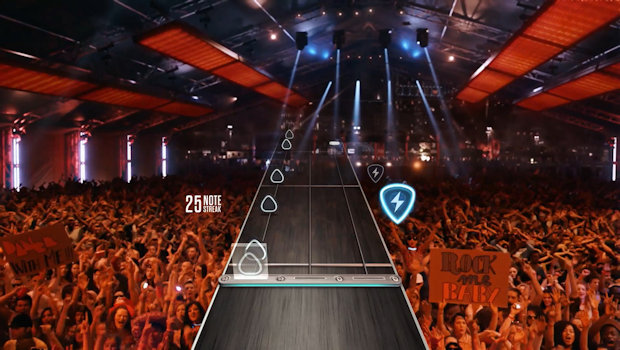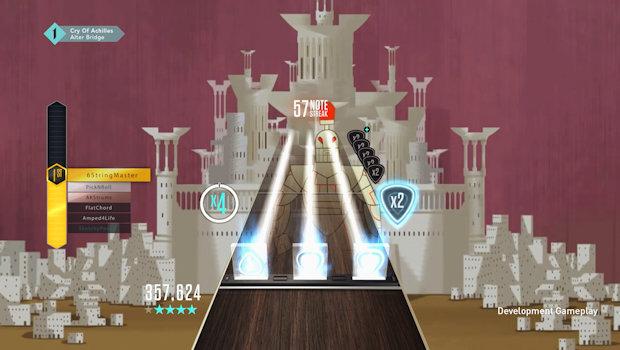Guitar Hero is the franchise that brought me into rhythm games. My first Guitar Hero game was Guitar Hero II on the Xbox 360 and from note one, I was hooked. Ever since, I have devoured all types of music and rhythm games which means I devoured a lot of Guitar Hero. I’ve played the best (Guitar Hero III, Guitar Hero: Metallica), the worst (Guitar Hero: Van Halen), the weird (Guitar Hero: On Tour), and everything in between up until the series went on hiatus after 2010’s Guitar Hero: Warriors of Rock. It’s been a long five years without Guitar Hero but Activision has revived the series with Guitar Hero Live, and it is like nothing that came before it.
Developed by Freestyle Games, the developer behind the experimental DJ Hero series, Guitar Hero Live throws almost everything you thought you knew about playing Guitar Hero out the window. Sure, Guitar Hero Live is still, at its most basic description, a game about using a plastic guitar controller to play notes as they come down a highway. But while the basic premise is still the same, Freestyle has adjusted exactly what all that means.
Gone are the Skittle colored gems that streamed down the highway on five tracks. In their place are three tracks that have both white and black notes. These white and black notes correspond to the buttons on the new guitar controller. Instead of five frets, Guitar Hero Live utilizes three frets split into two for six buttons on the controller. Black notes signify the top button on a fret, while whites are on the bottom. Honestly, as someone who has played an awful lot of plastic guitar over the years, it’s a big change.
I’m an OK Guitar Hero/Rock Band player. With the release of Rock Band 4, I was able to easily slide into my comfort zone, playing some songs on Expert, and most songs on Hard. Guitar Hero Live kicked my ass from the start. While I understood what the game wanted me to do, after years of playing with rainbow gems, my brain and hands weren’t working together and I felt just like I did the first time I picked up Guitar Hero II. And it was glorious.
Playing Guitar Hero Live required me to train my brain to be able to read a whole new language of black and white notes, while training my hands to interpret that code and translate it to the controller. The new notation scheme also allows for some pretty intricate combinations that will truly test your physical dexterity. I won’t lie, it didn’t take long to get a handle on it. And I suspect anyone that plays these rhythm games will be able to make the transition quickly as well. But even after 24 hours of playtime and a general mastery of the regular difficulty setting, I’m still finding certain button combinations vexing, which leaves me much room for growth as I move forward. That feeling of learning a new skill and growing with it as you play more is wonderful. It is also something that too many games just fail to deliver anymore.
The new guitar and its accompanying changes to the game mechanics are the biggest most important pieces of Guitar Hero Live but the game needs content to showcase itself. Thankfully Guitar Hero Live has plenty of content. The two modes the game boasts, Live and TV, might as well be two different games.
Live is the standard campaign we’ve all come to expect from games like this – preset songs played in a preset order. On the surface it is nothing fancy but then the game introduces you to what it actually is. The Live mode is first person guitar playing. You embody a lead guitarist on stage at a festival and play in front of a live crowd with your bandmates. And by live I mean full motion video. Yes, the Live game mode is an FMV game. As this ghostly guitar player, I interacted with my bandmates, my guitar techs, and the crowd. If I played well all of them were cheering me on. If I was struggling, they weren’t quite as cheery, with the fans booing me and my band and crew asking what was up with me. I’m not going to lie, it is all pretty damn goofy but it also really works.
There are a handful of bands to play with, each with their own unique identity, stage presence, song selection, and play style. Most of them are a ton of fun, and the best ones play up the goofy factor to crazy levels, like the Portland Cloud Orchestra, which played on a small stage with hippies, flower children, and a guy in a panda suit. To be fair though, it is no more goofy than what has been animated on stage in past Guitar Hero or Rock Band games, and for me I actually think I prefer this approach as it seems to be more for the player than those watching me play.
There are 42 songs in the Live portion of the game, which is a touch low when compared to past games or even the just release Rock Band 4 (60+), and like always, your mileage may vary depending upon your musical tastes. The Live track list skews heavily towards more modern music, which I didn’t necessarily mind but some might. Still, I thought almost all of the songs were fun to play through at least once. And if you aren’t into the Live tracks, or if the FMV is just too damn distracting for you, there is the TV mode as well.
TV mode is a weird beast. Think of it as interactive MTV, if MTV actually played music videos 24 hours a day. Guitar Hero TV plays music videos for popular songs and adds a note highway to it for you to play along with. As of right now there are 2 channels in Guitar Hero TV that have blocks of programming spanning a half hour to an hour in length. These blocks focus on a theme, like Metal or Pop, and play a randomized selection of videos for you to play along with. Don’t like what’s playing right now, check the programming schedule and see when what you want to play is on. While I really like the idea, this can lead to some weirdness if the channels aren’t playing anything you want to play during the time you are on. This is rectified a bit by having a selection of On Demand songs.
Every song that is in the Guitar Hero TV rotation is selectable in the On Demand section and that currently boasts over 200 total songs. There is one catch in regards to the On Demand songs though, to play one you have to burn a Play token. You’ll get a handful of these for starting Guitar Hero TV and then you’ll get them dished out as you level up. I have noticed though that the higher your level, the less play tokens you’ll get. Depending on your play style, you may be hurting for tokens and that is where it gets a touch sketchy. Play tokens can be purchased with in-game currency, earned by playing songs in Guitar Hero TV, either On Demand or on the channels, or they can be purchased with real money. If you have a allergic reaction whenever someone talks about microtransactions, Guitar Hero TV might make you break out in hives. I personally haven’t run into any issues with them and I also haven’t put any money into buying additional plays (or anything for that matter).
What I might put money into though is the Party Pass. The Party Pass is an option that lets you play all the songs On Demand for a 24 hour period, priced at $5.99 this is something that I’ve been long asking for in regards to Rock Band parties. That said, Guitar Hero Live isn’t really designed as a party game. There is the option of playing with another person (labeled as a Guest) and having rudimentary vocals but this game is more about you the solo guitar player, shredding away. I’m perfectly happy with that approach because I just enjoy these types of games but if you are looking for a more social experience – say a Rock Band experience – this isn’t that product.
And I’m glad it isn’t that product as well, this space of gaming is better when Guitar Hero and Rock Band aren’t trying to one up each other with the exact same type of game. It’s inevitable that the two are going to be compared to each other, they share too much DNA for people to not see the similarities. But where Rock Band 4 is a continuation the old formula, Guitar Hero Live evolves it just enough that it makes it something new and exciting.
This review was written with material provided by the publisher on the Xbox One console. For more on our review process, please read here.



